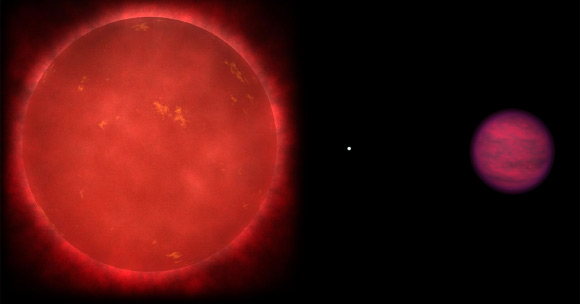Astronomers using the NASA/ESA/CSA James Webb Space Telescope have detected phosphine (PH3) in the atmosphere of Wolf 1130C, a metal-poor brown dwarf within the triple system Wolf 1130ABC.

Schematic of the Wolf 1130ABC triple system, composed of the red dwarf star Wolf 1130A (left), its close and compact white dwarf companion Wolf 1130B (center), and the distant brown dwarf Wolf 1130C (right); the three components of this system are shown scaled to their relative sizes. Image credit: Adam Burgasser.
Wolf 1130ABC is located approximately 54 light-years away in the constellation of Cygnus.
Also known LHS 482, Gliese 781 and Ross 1069b, this system consists of three components: the cool red star Wolf 1130A, the massive white dwarf Wolf 1130B, and the brown dwarf Wolf 1130C.
First discovered in 2013, Wolf 1130C follows a wide orbit around the tight double system of Wolf 1130A and Wolf 1130B.
“Our astronomy program, called Arcana of the Ancients, focuses on old, metal-poor brown dwarfs as a means of testing our understanding of atmospheric chemistry,” said University of California San Diego’s Professor Adam Burgasser.
“Understanding the problem with phosphine was one of our first goals.”
In the hydrogen-rich atmospheres of gas giant planets like Jupiter and Saturn, phosphine forms naturally.
As such, scientists have long predicted that phosphine should be present in the atmospheres of gas giants orbiting other stars, and in their more massive cousins, brown dwarfs.
Yet phosphine has largely eluded detection, even in prior Webb observations, suggesting problems with our understanding of phosphorus chemistry.
“Prior to Webb, phosphine was expected to be abundant in exoplanet and brown dwarf atmospheres, following theoretical predictions based on the turbulent mixing we know exists in these sources,” said Dr. Sam Beiler, a postdoctoral researcher at Trinity College Dublin.
Wolf 1130C has been a favorite source for brown dwarf astronomers due to its low abundance of ‘metals’ — essentially any elements other than hydrogen and helium — compared to the Sun.
Unlike other brown dwarfs, the authors spotted phosphine in Webb’s infrared spectral data of Wolf 1130C.
To fully understand the implications of their findings, they needed to quantify the abundance of this gas in Wolf 1130C’s atmosphere.
“To determine the abundances of molecules in Wolf 1130C, I used a modeling technique known as atmospheric retrievals,” said San Francisco State University’s Dr. Eileen Gonzales.
“This technique uses the Webb data to back out how much of each molecular gas species should be in the atmosphere.”
“It’s like reverse engineering a really delicious cookie when the chef wouldn’t give up the recipe.”
“It may be that in normal conditions phosphorus is bound up in another molecule such as phosphorus trioxide,” Dr. Beiler said.
“In the metal-depleted atmosphere of Wolf 1130C, there isn’t enough oxygen to take up the phosphorus, allowing phosphine to form from the abundant hydrogen.”
Another possibility is that phosphorus was generated locally in the Wolf 1130ABC system, specifically by the white dwarf Wolf 1130B.
“A white dwarf is the leftover husk of a star that has finished fusing its hydrogen,” Professor Burgasser said.
“They are so dense that when they accrete material on their surface they can undergo runaway nuclear reactions, which we detect as novae.”
While astronomers haven’t seen evidence of such events in the Wolf 1130ABC system in recent history, novae typically have outburst cycles of thousands to tens of thousands of years.
This system has been known for just over a century, and early, unseen outbursts could have left a legacy of phosphorus pollution.
Understanding why this one brown dwarf shows a clear signature of phosphine may lead to new insights into the synthesis of phosphorus in the Milky Way and its chemistry in planetary atmospheres.
“Understanding phosphine chemistry in the atmospheres of brown dwarfs where we don’t expect life is crucial if we hope to use this molecule in the search for life on terrestrial worlds beyond our Solar System,” Professor Burgasser said.
The study appears today in the journal Science.
_____
Adam J. Burgasser et al. Observation of undepleted phosphine in the atmosphere of a low-temperature brown dwarf. Science, published online October 2, 2025; doi: 10.1126/science.adu0401




![The image shows NGC 1866 superimposed with a false color image from the MUSE data cube, where the ionized shell of the planetary nebula Ka LMC 1 is seen as a red ring. The grayscale insets illustrate the different size of the ionized shells of singly ionized nitrogen [N II] and doubly ionized oxygen [O III]. The magnified Hubble image near the center of the ring reveals the presence of a pale blue star -- most probably the hot central star of Ka LMC 1. Image credit: AIP / M.M. Roth / NASA / ESA / Hubble.](https://cdn.sci.news/images/2025/11/image_14348-Ka-LMC-1-104x75.jpg)


